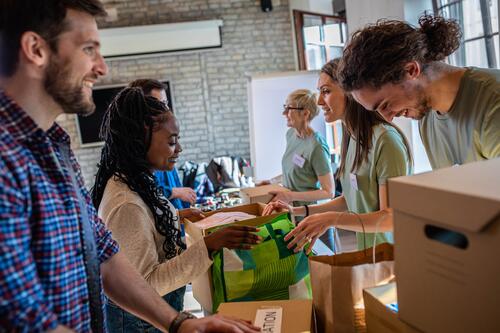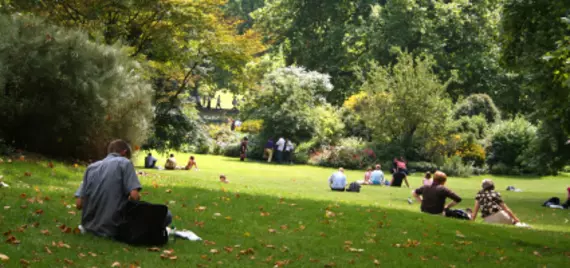Community and Wellbeing

A vast group of online gamers calls itself a community. So do the six people who live in a small residence. Communities range far and wide, in physical locations and on the web. So what do we mean by community?
In our wellbeing model, we are talking about societal groups that live in a defined geographical area and share physical and governmental resources. This kind of community exists at different levels, from neighborhoods to towns to states and countries.
Community wellbeing is an interesting concept because it exists in the wellbeing of both:
- the individuals who make up that community
- the larger “superorganism” of the community (and in the norms and habits that arise within that community)
Of course, there is a great deal of interaction between individuals and their communities, with each directly influencing the other, as we shall see.
Interact for the wellbeing of all!
Find out how to enrich your community.
A healthy community:
- Promotes equity
- Creates trust
- Fosters altruism
- Lowers the crime rate
- Reduces corruption
- Enhances the health of all
Our community has a big impact on our health and wellbeing. It can provide us with social support, a sense of belonging, and opportunities for physical activity and engagement. It can also help us to feel safe and secure. It is found that various aspects of a community involvement in one’s life can reduce stress, improve mental and emotional health, increase physical activity and also lower the risk of suicide.
Social Supp ort
ort
Social support is the network of people who care about us and who we can rely on for help and support.
It can come from family, friends, neighbors, and members of our community. Social support has been
shown to have a number of benefits for health, namely:
- Coping with stress: When people have a strong social network, they are more likely to have people to talk to about their problems. This can help them to cope with stress in a healthy way.
- Managing illness: People with illnesses often find it helpful to have friends and family who can provide emotional and practical support. This support can help them manage their illness and focus on their health.
- Staying mentally healthy: People who have a strong social network are less likely to experience mental health problems, such as depression and anxiety. Social support can help people feel connected to others and deal with issues in a healthy manner.
Overall, social support is an important part of a healthy lifestyle. By building strong relationships with
others, people can improve their physical and mental health, cope with stress, and live a longer, happier
life.
Sense of Belonging
A sense of belonging is the feeling that we are part of something larger than ourselves. It comes from
feeling connected to our community and to the people around us. A sense of belonging has been shown
to have a number of benefits for health, some of which are to:
- Feel happier and more satisfied with life: People who feel like they belong to a community are more likely to report feeling happy and satisfied with their lives since they can share moments and have a support system.
- Be healthier: People who feel like they belong to a community are more likely to take care of their health. This may be physical or emotional, which could be a result of observing community members or friends. They are also more likely to get the help they need if they are sick or injured.
Opportunities for Physical Activity
Our community can provide us with opportunities for physical activity, which is essential for our health.
Physical activity can help us to maintain a healthy weight, reduce our risk of chronic diseases, and improve our mood and energy levels. Below are ways by which a community can improve someones
physical health.
- Motivation: Having a strong social network can help people stay motivated to exercise. When people have friends and family members who are supportive of their fitness goals, they are more likely to stick with their exercise routine.
- Access to facilities: Communities can provide access to safe and convenient places to exercise, such as parks, recreation centers, and walking trails. This can make it easier for people to get the exercise they need. Education and awareness: Communities can educate people about the importance of physical activity and provide information about different types of exercise. This can help people make informed decisions about their fitness goals.
- Events and activities: Events and activities can be organized that promote physical activity, such as walking clubs, running groups, and fitness classes. This can make it fun and easy for people to get exercise.
Opportunities for Engagement
Our community can also provide us with opportunities for engagement, which can help us to feel a
sense of purpose and meaning in our lives. Engagement can take many forms, such as volunteering,
participating in community events, or learning new skills. Engagement has been shown to have several
benefits for emotional wellbeing.
Safety and Security
A safe and secure community is one where we feel comfortable walking around at night, where we don't
have to worry about crime, and where we feel like we can trust our neighbors. A safe and secure
community can have a number of benefits for health, including:
- Reduced stress
- Improved mental and emotional health
- Increased physical activity
- Lower risk of victimization
Our community has a big impact on our health and wellbeing. By providing us with social support, a
sense of belonging, opportunities for physical activity and engagement, and safety and security, our
community can help us to live healthier and happier lives.
How Can You Get Involved in Your Community?
Here are a few ideas:
- Volunteer your time to a local organization.
- Vote in local and national elections.
- Attend community events.
- Learn about the issues facing your community and get involved in advocacy efforts.
- Get to know your neighbors.
- Support local businesses.
- Take care of your environment.
By getting involved in your community, you can help to make it a healthier and happier place for
everyone.
- Almedom, A. M., & Glandon, D. (2020). Social capital and mental health: An updated interdisciplinary review of primary evidence. Social Science & Medicine, 251, 112782.
https://www.sciencedirect.com/science/article/pii/S0277953605000249?cas… - Henderson, C., & Robertson, C. (2021). A systematic review of the relationship between community cohesion and mental health. Journal of Public Mental Health, 20(1), 48-57.
- Kemp, S. P., & Smith, J. L. (2021). The relationship between community engagement and mental health: A systematic review. Journal of Community & Applied Social Psychology, 31(1), 4-18.
- Nguyen, T. H., & Wilkinson, R. G. (2021). Social determinants of mental health: A systematic review of the literature. Social Science & Medicine, 266, 113371.
- Shaw, J., & Timperio, A. (2021). The relationship between neighborhood social cohesion and physical activity: A systematic review. Journal of Physical Activity & Health, 18(1), 8-17.
- Golaszewski NM, LaCroix AZ, Godino JG, et al. Evaluation of Social Isolation, Loneliness, and Cardiovascular Disease Among Older Women in the US. JAMA Netw Open. 2022;5(2):e2146461. doi:10.1001/jamanetworkopen.2021.46461
- Brewin, C. R., Andrews, B., & Valentine, J. D. (2017). Psychological well-being: A comprehensive guide. Oxford University Press.




